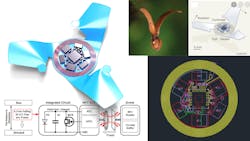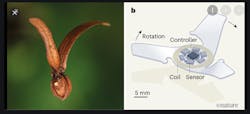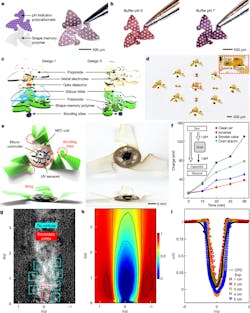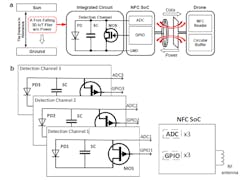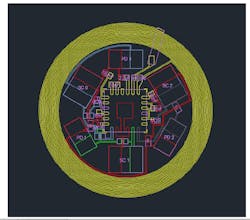Seed-Inspired Battery-Free Microflier Collects Data as It Drifts Along
What you’ll learn:
- The nature-inspired idea behind these tiny spinning fliers.
- How a dust-sensing electronics package was incorporated into the microflier center.
- The many mechanical and airfoil aspects to these devices.
Just when you think micro-data-acquisition systems can’t get any smaller, along comes a winged microchip that’s claimed to be the smallest-ever human-made flying structure—and it has substantial electronics on board.
A multi-university team led by Northwestern University has developed and tested a microflier that doesn’t have a motor or engine. Instead, it catches flight on the wind—much like a maple tree’s propeller seed—and spins like a helicopter through the air toward the ground while the wings create lift.
The team optimized the microflier’s aerodynamics to ensure that when dropped at a high elevation, it floats and falls at a slow velocity in a controlled manner. This behavior stabilizes its flight, ensuring dispersal over a broad area and increasing the amount of time it interacts with the air, thus making microflier suitable for monitoring air pollution and airborne disease.
“Our goal was to add winged flight to small-scale electronic systems, with the idea that these capabilities would allow us to distribute highly functional, miniaturized electronic devices to sense the environment for contamination monitoring, population surveillance or disease tracking,” said Northwestern’s John A. Rogers, who led the device’s development. “We were able to do that using ideas inspired by the biological world.”
Microflier Structure
The microfliers are composed of two parts: millimeter-sized electronic components plus their wings. The team analyzed and built different 2D and 3D wing structures, as no single structure is optimal for all conditions. One very successful wing structure with a four-centimeter diameter weighed 14.6 milligrams (mg) and supported a payload of nearly 75 mg (Fig. 1).
As the microflier falls, its wings interact with the air to create a slow, stable rotational motion. The weight of the electronics is distributed low in the center of the microflier to prevent it from losing control and chaotically tumbling to the ground.
While much of the work focused on the microfliers, there’s much more to the mechanical design than a simple multi-winged device that drifts and rotates while carrying the tiny on-board electronics. They investigated design options and optimization of the wing size, shape, and curvatures. The team also looked at construction techniques for microscale (microfliers with half widths of wings under 1 mm), mesoscale (mesofliers with half widths of about 1 mm), and macroscale units (macrofliers with half widths above 1 mm).
By launching many of these microfliers and other fliers with suitable electronics, ambient air conditions over an area can be monitored, to cite one application. Figure 2 provides many perspectives on the project.
Dosimeter Application
While many on-board electronics packages are possible, one to which they devoted considerable effort was a battery-free, three-channel dosimeter for fine-dust monitoring (Figs. 3 and 4).
When exposed to light, the photodiode continuously generates a photocurrent and a supercapacitor passively stores the accumulated charge. The voltage bias of the supercapacitor is read by the analog-to-digital converter and is proportional to the total exposure “dose.” Simultaneous dosimetry at up to three different wavelengths is possible through selection of the photodiode.
A near-field communication (NFC) system-on-chip (SoC) enables battery-free, wireless data transfer and power transmission. And a wirelessly activated general-purpose I/O (GPIO) pin supplies 1.5 V to the gate of the MOS switch to trigger discharge of the supercapacitor discharge. (They even provide a full bill of materials with vendor name, part description, and number.)
Multiple Microflier Designs
Rogers and his team designed and built many different types of microfliers, including the one described with three wings optimized to similar shapes and angles as the wings on a tristellateia seed. To pinpoint the best structure, they developed and used full-scale computational models of how the air flows around their devices to mimic the tristellateia seed’s slow, controlled rotation.
“The computational modeling allows a rapid design optimization of the fly structures that yields the smallest terminal velocity,” said Huang. “This is impossible with trial-and-error experiments.”
Based on this modeling, Rogers’ group then built and tested structures in the lab, using advanced methods for imaging and quantifying patterns of flow. His team first fabricated precursors to flying structures in flat, planar geometries. Then, they bonded these precursors onto a slightly stretched rubber substrate. When the stretched substrate is relaxed, a controlled buckling process occurs that causes the wings to “pop up” into precisely defined three-dimensional forms.
What about potential litter from hundreds or thousands of these microfliers being launched and drifting all over? The project has anticipated that as well.
“We fabricate such physically transient electronics systems using degradable polymers, compostable conductors, and dissolvable integrated circuit chips that naturally vanish into environmentally benign end-products when exposed to water,” said Rogers. “We recognize that recovery of large collections of microfliers might be difficult. To address this concern, these environmentally resorbable versions dissolve naturally and harmlessly.”
In addition to Northwestern University, other researchers in this project were from the University of Illinois, Tsinghua University in China, Soongsil University in Korea, and University of Science and Technology in China, as well over a dozen other institutions.
The work is described in detail in the abstract and paper with the largest number of co-authors I have ever seen (34!) “Three-dimensional electronic microfliers inspired by wind-dispersed seeds” published in Nature. While that posting is behind a paywall, the paper also is available as a preprint here. The abstract page (but not the preprint) has active links to seven videos and extended test-result data.
Finally, there’s a 43-page Supplementary Information file that includes extensive analysis done for the project across many dimensions: fluid mechanics, mechanical modeling, fabrication, tests including the “wind tunnel” arrangement, and much more.
About the Author

Bill Schweber
Contributing Editor
Bill Schweber is an electronics engineer who has written three textbooks on electronic communications systems, as well as hundreds of technical articles, opinion columns, and product features. In past roles, he worked as a technical website manager for multiple topic-specific sites for EE Times, as well as both the Executive Editor and Analog Editor at EDN.
At Analog Devices Inc., Bill was in marketing communications (public relations). As a result, he has been on both sides of the technical PR function, presenting company products, stories, and messages to the media and also as the recipient of these.
Prior to the MarCom role at Analog, Bill was associate editor of their respected technical journal and worked in their product marketing and applications engineering groups. Before those roles, he was at Instron Corp., doing hands-on analog- and power-circuit design and systems integration for materials-testing machine controls.
Bill has an MSEE (Univ. of Mass) and BSEE (Columbia Univ.), is a Registered Professional Engineer, and holds an Advanced Class amateur radio license. He has also planned, written, and presented online courses on a variety of engineering topics, including MOSFET basics, ADC selection, and driving LEDs.
